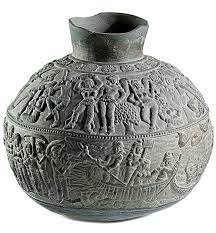In the idyllic setting where the Vaigai, Marudhanadhi, and Manjalar rivers converged at Kunnuvarankottai, a remarkable toll gate known as a chunga chavadi was erected by the Pandya kings. This strategic location, nestled just a furlong away from the meeting point of these frothing rivers, became a vibrant hub of trade and cultural exchange.
During the monsoon season, the rivers surged with force, carrying with them rich alluvial soil that originated from the lofty Western Ghats. The fertile land surrounding the rivers was adorned with lush vegetation, particularly coconut groves, which provided a soothing shade for weary travelers and traders. These merchants, after paying the customary six percent toll levied by the kings, sought respite in the tranquil oasis.
As the rivers roared in the background, the bustling atmosphere of the chunga chavadi resonated with the mingling of old acquaintances and the forging of new friendships. Among the diverse array of individuals congregating there were a group of people known as the “yavanas” to the local traders. These yavanas were none other than Roman merchants and soldiers who had ventured into the region to engage in trade, particularly in the sought-after commodity of black gold—pepper. Just a sprinkling of this spice was enough to impart a distinct flavor to Roman cuisine, making it highly desirable.
The presence of these Roman traders added an intriguing cosmopolitan touch to the local scene. Their arrival brought with it new customs, goods, and ideas, enriching the cultural tapestry of the region. The chunga chavadi became a vibrant melting pot where the vibrant colors of the local traditions blended with the exotic flavors of distant lands.
As the merchants conducted their business, they would engage in lively conversations, their voices rising above the tumultuous waters. The exchange of goods was not the only thing taking place; knowledge, stories, and experiences were also bartered. The yavanas shared tales of their far-flung expeditions, regaling the locals with accounts of distant lands and remarkable civilizations.
The chunga chavadi became a microcosm of the global interconnectedness that defined the ancient world. It served as a meeting point for cultures, a crossroads where people from different corners of the earth converged, leaving an indelible mark on the collective memory of the region. It was a testament to the human inclination for exploration, discovery, and trade, transcending geographic boundaries and fostering connections that went beyond the immediate vicinity.
Over time, the chunga chavadi became more than just a toll gate. It evolved into a symbol of unity, a place where diverse cultures intersected, leaving an enduring legacy. The echoes of those animated conversations and the scents of exotic spices lingered in the air, reminding subsequent generations of the vibrant tapestry of the past.
Today, the chunga chavadi stands as a testament to the dynamic history of the region, reminding us of the power of trade, cultural exchange, and human connection. It serves as a reminder that even in the midst of the tumultuous waters of life, the rivers of commerce and camaraderie continue to flow, shaping our world and leaving an imprint on the landscapes of our shared heritage.


